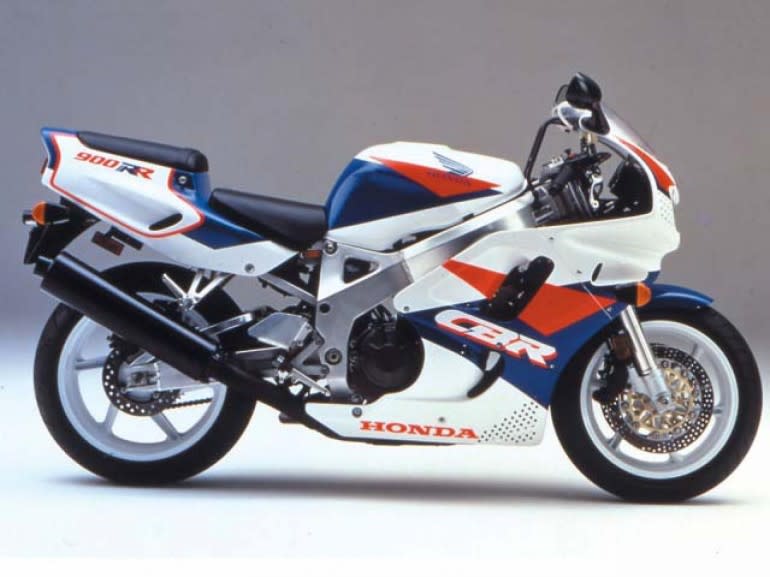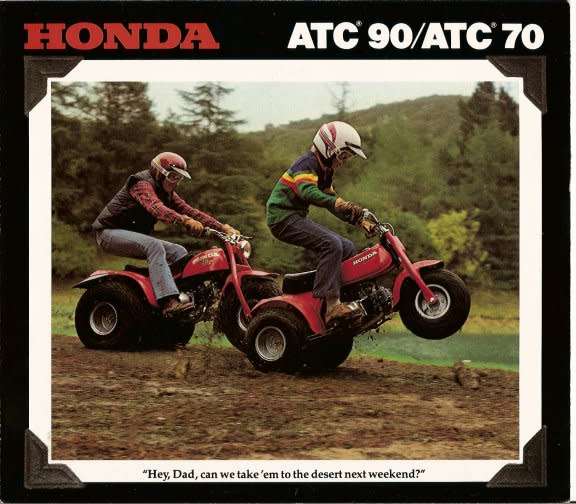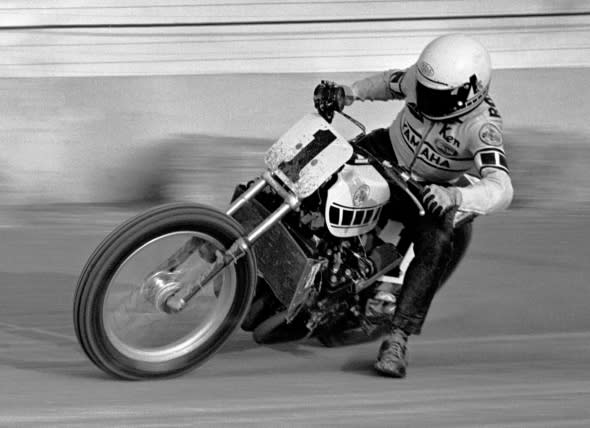Top 10 Most Frightening Motorcycles
Some people are just scared of all motorcycles, even 50cc mopeds with a top speed slower than an Olympic sprinter. But there exist a handful of bikes with a reputation of being frightening, not just among the general public, but with trained professional riders and members of the moto-press alike. In 2015 with every commuter bike having over 100hp and the ability to top “the ton” easily, it can be hard to see what all the fuss was about on some of these. You have to remember though, when many of these bikes were new engine power was way ahead of suspension and chassis design, and brakes and tires were not even up to the standard of today's cheap mountain bikes.
READ MORE: 10 Essential Ways To Prepare For A Bad Motorcycle Crash | RideApart
1) 1992-95 Honda CBR900RR

These bikes have much the same reputation problem as the 1985 GSX-R 750; the Fireblade was so much lighter and quicker handling than the contemporary liter bikes it was scary. It is mostly a totally conventional bike for its day, but the fear comes from the 16” front wheel, when most bikes had moved to 17" rims. A smaller wheel makes a bike turn in quicker, which is a good thing if you are hustling up a tight canyon, but a bad thing if you are stunting from the bar to the beach in a half helmet and flip flops. There is no reason to be scared of the CBR900RR, unless you are a nervous rider who hasn’t learned throttle control and proper steering inputs, but that being said, it is not a bike for newbies.
2) 1997-2000 Suzuki TL1000s

These were excellent bikes, created at the same time as the Honda Superhawk 996 to challenge Ducati’s hold on Superbike Racing, but Suzuki was too clever by half. At the back of their fairly conventional chassis they chose to fit a separate spring and rotary damper with pushrods, instead of a coil over shock. The smaller rotary damper contained less oil than a normal shock, and had smaller metering orifices, both of which led to a rear end that could become vague when the oil got hot and frothy. In normal usage they are great bikes, but if you ride tight and technical courses you may notice the rear end not keeping up with the front. Cook the rear shock and the rear wheel won’t have much traction, which can easily put you on your ass when you overpower the tire with the abundant torque of the V-twin.
3) 1985 Suzuki GSX-R 750

Any GSX-R will scare you if you don’t respect the power it has, but that first year it was more about the handling. The 1985 GSX-R 750 has an inch shorter swingarm than later bikes of this generation and many people blame the shorter wheelbase on it being nervous and unstable at speed. Now, with 30 years of hindsight, it looks like it may have been that riders were not prepared for how radically different the Gixxer was. Weighing about 400lbs, with 100hp, a 56” wheelbase, and a rake of about 25 degrees, it doesn’t seem very radical today, but if you compared it to the 500+lb GS750 with 75hp, a wheelbase of nearly 60”, and a rake of nearly 30 degrees, it would seem as nervous as a BMX bicycle. Ride a first year GSX-R (not officially imported to the US) like a sport bike from 1995 and it will seem pretty normal, ride it like a bike from 1975 and it is going to feel like a race horse after a few coffees. You should respect the GSX-R, but no reason to be scared of it.
4) 3-Wheeled ATVs

These became so popular so quickly in the 1980s that no one thought them through properly. When they began as little balloon-tired back woods crawlers with a top speed of 25 mph, their dangerous handling characteristics didn’t really matter. When they became the hottest Christmas toy (blame James Bond) for middle and high school kids who went out goofing around with no gear or supervision, is it any wonder a bunch of them got hurt? Because we are Americans, we clamored for bigger and faster trikes and the factories made them, and lots more people ended up pinned under a heavy trike at the bottom of a ditch, often with broken limbs. Because in the 1980s there were still leftover activist regulators from the Carter Era, 3-wheeled ATVs were nearly recalled and outlawed completely. In the end there was a compromise: the companies agreed to stop selling 3 wheeled ATVs and offer free safety classes to anyone who had bought a trike, or the new 4-wheeled models. You still see these trikes occasionally and they require a bizarre type of body English to ride fast. These trikes are especially popular with guys who limp and talk about how they don’t let the government tell them what to do.
READ MORE: QOTD: What Was Your Scariest Moment on a Motorcycle? | RideApart
5) 1975 Yamaha TZ750 flat tracker

There is no reason for you to fear this bike, because it is as rare as Bigfoot or the Loch Ness Monster. There are very few of these, and at this point they are pretty much all locked up in museums for safety. Kenny Roberts, one of the most talented road race and dirt track riders ever, raced it once and won the Indianapolis mile on it, but said never again. He was quoted as saying “they don’t pay me enough to ride that thing” and he was getting pretty well paid at the time. He has ridden exhibition laps on it in recent years, but even on the best tires currently available 125hp from a peaky 2-stroke 4-cylinder motor is just too much in the dirt.
6) The 1971-74 Suzuki TM400

The TM400 was Suzuki’s first serious production open-class motocross bike. Suzuki had been racing hand built works bikes and winning, and this production version promised to have world class power. Bundle that power with lousy shock and fork damping, and a flexible frame with bad geometry and you got a bike that was a real handful. On top of that, the motor features the aptly named Pointless Electronic Ignition, with an electronic advance curve. The electronics advanced the ignition based on voltage output not rpm and it was not very accurate. You'd be trying to manage the ill-handling bike in the dirt and, with no real warning, the power would come on. Sometimes it would hit at 4000rpm, sometimes 5000, sometimes 4500, and it always seemed to do it in mid corner. Suzuki added heavier flywheels to calm it down, and fixed the ignition advance issue completely for 1975. Now a TM400 with the more predictable ignition, good shocks, and a braced frame you'll have one of the fastest bikes in a vintage MX race, but still not much of a handler compared to a Maico or CZ.
7) The Kawasaki 2 stroke triples

In 1969, Kawasaki came out with the H1 Mach III 500cc 2-stroke triple, then followed it with the H2 Mach IV 750cc version in 1972. These bikes had many reasons to scare the public, but like the current popularity of ghost peppers, some people enjoyed the adrenaline rush and punishment that came with trying to ride them. Both bikes weighed about 400lbs, both had the rider far back over the wheel, and both would wheelie easily when the 2-stoke motors came on the power. They also had thin, lightweight, tubular frames with not much torsional rigidity, even when coping with the modest grip of early 70s tires. The front forks flexed too, being just 34mm in diameter, which was thinner than many mid-size street bikes of the day. The original drum brake on the H1, and later discs, weren't very good either. These bike suffered from a similar ignition problem as the TM400, the early CDI ignition controlled the advance electronically, and varied it with engine speed.These days, updated with modern tires, suspension, brakes, and a few well-placed frame gussets, it is hard to see what all the fuss was about. I mean, how can 60 horsepower, or 74 in the case of the 750, scare anyone?
READ MORE: Making Tiered Licensing Work In The USA | RideApart
8) The Vincent Black Shadow, Black Prince and Black Knight

Just the names of these bikes can strike fear in the heart of older bikers, or even small children who have never seen one. They just sound menacing. People who rode them back in the day still bend your ear about the terrifying experience. The spec sheets don't look too extreme, but back when they were introduced they were the fastest thing in the world. The troubling issues are all handling and braking. Vincents feature twin 7” single leading shoe drums up front, and a 3rd drum of same size in the back. Honda Dreams, with 1/2 the power, had better brakes when they came out just 10 years later. The Vincent also has no frame, the engine is a stressed member and the fork and swingarm just bolt to it. This was advanced in the 1930s when it was developed for bikes with 25hp, but post-war power made it frightening, with a flexible, cantilevered swingarm, and weird girder/hydraulic front. The Vincent motor however was a real powerhouse, and guys continued to build and race Vincent powered bikes, with much more conventional chassis into the 1970s. For some strange reason they are still wildly popular in the Australia and New Zealand.
9) Anything with a V8

Including this is kind of cheating because for a long time the only V8 bikes were home-built jobs like the rather agricultural drag bikes of E.J.Potter, the “Michigan Mad Man” (R.I.P.). But now Boss Hoss makes dozens of them a year, each with a full-sized automotive V8, and they are only really slightly better engineered than the ones E.J. built. At least the modern V8 bikes have the benefit of modern disc brakes, hydraulically dampened suspension, and a clutch; 3 things most of Potter’s bikes did without.
10) Someone Else’s Project

There is nothing more frightening than a bike that has been built or modified by someone of dubious talent and knowledge. All it takes is a quick spin around Craigslist, searching for the terms “project,” “bobber,” “custom” or “café racer” to turn up any number of bikes that will have you saying WTF. Many times these projects are started with the best of intentions, but the absolute worst are the ones that are started in an attempt to make a quick buck, or resurrect a wadded up bike.

Suzuki GSF600

Follow RideApart on Facebook and Twitter, along with @RideApart on Instagram.


